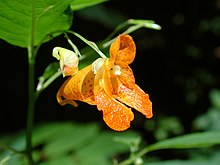This is an old revision of this page, as edited by Lightbot (talk | contribs) at 21:31, 10 November 2008 (Date audit per mosnum/overlink/Other). The present address (URL) is a permanent link to this revision, which may differ significantly from the current revision.
Revision as of 21:31, 10 November 2008 by Lightbot (talk | contribs) (Date audit per mosnum/overlink/Other)(diff) ← Previous revision | Latest revision (diff) | Newer revision → (diff)
| Impatiens | |
|---|---|
| File:ImpatiensGlandulifera-flower-sm.jpg | |
| Himalayan Balsam | |
| Scientific classification | |
| Kingdom: | Plantae |
| Division: | Magnoliophyta |
| Class: | Magnoliopsida |
| Order: | Ericales |
| Family: | Balsaminaceae |
| Genus: | Impatiens L. |
| Species | |
|
See text | |





Impatiens is a genus of about 900-1000 species of flowering plants in the family Balsaminaceae. The genus has a wide distribution throughout the northern hemisphere and tropics.
Some species are annual plants and produce flowers from early summer until the first frost, while perennial species, found in milder climates, can flower all year. They can exist both in, and out, of direct sunlight. Impatiens walleriana hybrids have commercial importance as garden plants with a yearly business volume of about US $230 million. This species of Impatiens were originally collected as weeds from Costa Rica, and bred through selection by Claude Hope. The original series of impatiens bred by Hope was the Elfin series, which has now been upgraded and is known as the Super Elfin series.
Major common names for one or more species include Balsam, Jewelweed, and Busy Lizzie.
The plant derives its scientific name Impatiens ("impatient") and the common name "touch-me-not" from the plant's seed pods. When the seed pods mature, they "explode" when touched, sending seeds several meters away. This mechanism is also known as "explosive dehiscence". See also Rapid plant movement.
- Selected species
- Impatiens acehensis
- Impatiens arguta
- Impatiens arriensii
- Impatiens auricoma
- Impatiens balfourii - Kashmir Balsam
- Impatiens balsamina - Rose Balsam
- Impatiens bicornuta
- Impatiens campanulata
- Impatiens capensis - Spotted Jewelweed, Orange Balsam
- Impatiens celebica
- Impatiens chinensis
- Impatiens cristata
- Impatiens dempoana
- Impatiens dewildeana
- Impatiens diepenhorstii
- Impatiens edgeworthii
- Impatiens etindensis
- Impatiens eubotrya
- Impatiens flaccida
- Impatiens forbesii
- Impatiens frithii
- Impatiens glandulifera - Himalayan Balsam, Policeman's Helmet
- Impatiens gordonii
- Impatiens grandis
- Impatiens grandisepala
- Impatiens hawkeri - New Guinea impatiens
- Impatiens heterosepala
- Impatiens holstii
- Impatiens irvingii
- Impatiens javensis
- Impatiens jerdoniae
- Impatiens kilimanjari - Kilimanjaro Impatiens
- Impatiens korthalsiana
- Impatiens letouzeyi
- Impatiens linearifolia
- Impatiens malabarica
- Impatiens marianae
- Impatiens meruensis
- Impatiens mirabilis
- Impatiens morsei
- Impatiens namchabarwensis - Blue Diamond Impatiens
- Impatiens niamniamensis - Parrot Plant, Congo Cockatoo
- Impatiens noli-tangere - Touch-me-not Balsam
- Impatiens obesa
- Impatiens omeiana
- Impatiens oppositifolia
- Impatiens pallida - Pale Jewelweed
- Impatiens parviflora - Small Balsam
- Impatiens petersiana
- Impatiens platypetala
- Impatiens pritzelii
- Impatiens pseudoviola
- Impatiens psittacina
- Impatiens pyrrhotricha
- Impatiens repens - Ceylon Balsam
- Impatiens rosulata
- Impatiens sakerana
- Impatiens scabrida
- Impatiens sidikalangensis
- Impatiens singgalangensis
- Impatiens sivarajanii
- Impatiens sodenii - Poor Man's Rhododendron
- Impatiens sulcata
- Impatiens sumatrana
- Impatiens tapanuliensis
- Impatiens teysmanni
- Impatiens tinctoria
- Impatiens walleriana - Busy Lizzie
- Impatiens wilsoni
Impatiens species are used as food plants by the larvae of some Lepidoptera species including Dot Moth.
The balsam used in shampoos (Tolu balsam, or Balsam of Peru), is derived from the unrelated plant Myroxylon.
Diseases
Main article: List of impatiens diseasesBotanical References
- Flora Europaea: Impatiens
- Flora of China: Impatiens species list
- Flora of Madagascar: Impatiens species list
- UK National Plant Collection of Impatiens